标签:跳转 ppi utils proc 返回 err 引导 错误信息 alt
1.定义自己的登录页面在实际的开发中,则需要更精细力度的登录控制,记录错误的日志(错误的次数等)
2.自定义登录页面
http.formLogin()
.loginPage("/sign.html") //位于resources/resources/sign.html
.and()
.authorizeRequests()
.anyRequest().authenticated();页面内容如下:
<!DOCTYPE html>
<html>
<head>
<meta charset="UTF-8">
<title>sign.html</title>
</head>
<body>
<h2>标准登录页面</h2>
<h3>表单登录</h3>
<form action="/authentication/form" method="post">
<table>
<tr>
<td>用户名:</td>
<td><input type="text" name="username"></td>
</tr>
<tr>
<td>密码:</td>
<td><input type="password" name="password"></td>
</tr>
<tr>
<td colspan="2"><button type="submit">登录</button></td>
</tr>
</table>
</form>
</body>
</html>启动之后,访问我们的路径:http://localhost:8080/sign.html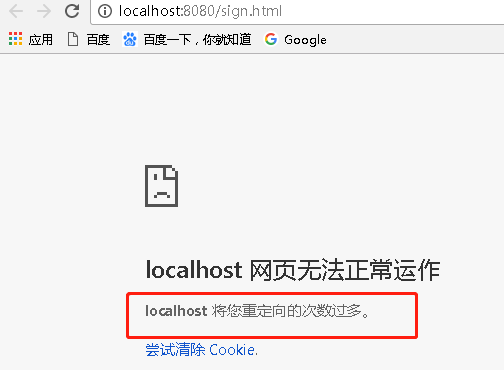
这个时候浏览器会报错:重定向的次数过多,这是为什么呢?
因为在配置中,我们只是配置了loginPage("/sign.html"),但是又没有给该请求做授权,又因为没有做授权,又被跳转给sign.html页面,所以会是:重定向的次数过多。
此时:需要再配置授权路径,改造之后
http.formLogin()
.loginPage("/sign.html")
.and()
.authorizeRequests()
.antMatchers("/sign.html").permitAll() //当访问sign.html这个页面的时候不需要进行身份认证
.anyRequest().authenticated();在sign.html中,自己配置了一个post路径,在spring security原理中,表单登录实际上是由UsernamePasswordAuthenticationFilter这个过滤器来处理的,在这个过滤器中
处理的是/login 请求,为了让UsernamePasswordAuthenticationFilter这个过滤器知道处理我们自定义的登录路径/authentication/form,还需要再配置登录的处理请求
http.formLogin()
.loginPage("/sign.html")
.loginProcessingUrl("/authentication/form") //登录请求
.and()
.authorizeRequests()
.antMatchers("/sign.html").permitAll()
.anyRequest().authenticated();启动之后,继续访问我们的路径:http://localhost:8080/sign.html
输入账户名和密码,登录之后会报错,403

在默认情况下,spring security提供了跨站请求伪造的防护,用CSRF Token来完成的,在***和防护的时候再细讲,目前先把跨站请求伪造的功能先disable掉。
http.formLogin()
.loginPage("/sign.html")
.loginProcessingUrl("/authentication/form") //登录请求
.and()
.authorizeRequests()
.antMatchers("/sign.html").permitAll()
.anyRequest().authenticated()
.and()
.csrf().disable();启动之后,继续访问我们的路径:http://localhost:8080/user/1 ,系统会帮我们重定向到sign.html页面
此时我们输入正确的用户名和密码就可以访问我们的请求了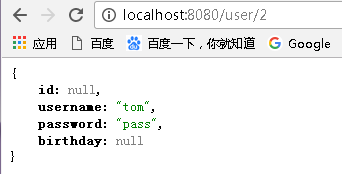
3.优化rest请求和html请求
完成了基本功能之后还需要继续优化我们的代码结构,是要面向可重用的一种。
目前有2个问题:
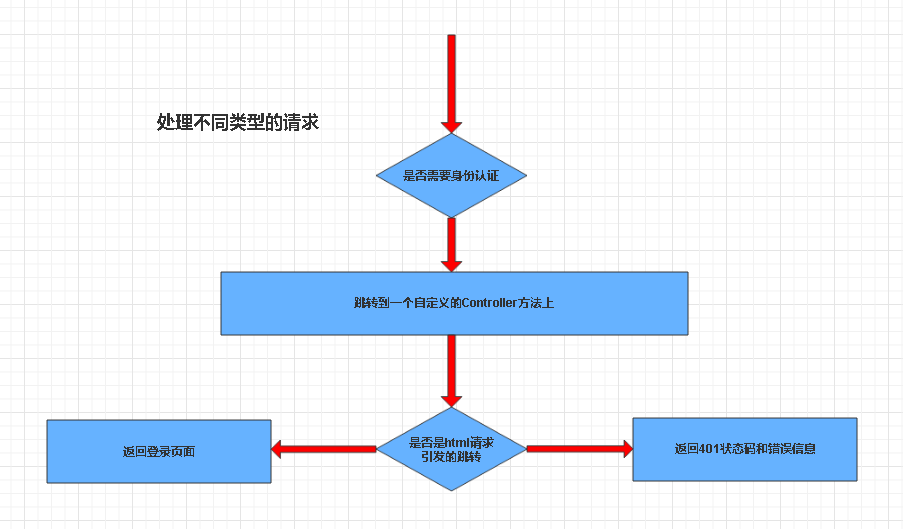
当我们接收到html请求或者数据请求的时候,先判断是否需要身份认证(spring security来做的)如果是否的话就直接返回了,如果是的话则需要跳转到我们自定义的Controller上面去(目前我们的做法是跳转到了sign.html页面上)在该方法内判断是html请求还是数据请求。
Controller
@RestController
public class BrowserSecurityController {
private Logger logger = LoggerFactory.getLogger(BrowserSecurityConfig.class);
//拿到引发跳转的请求(HttpSessionRequestCache把当前的请求缓存到Session中)
private RequestCache requestCache = new HttpSessionRequestCache();
private RedirectStrategy redirectStrategy = new DefaultRedirectStrategy();
@Autowired
private SecurityProperties securityProperties;
//当需要身份认证时,跳转到这里
@RequestMapping("/authentication/require")
@ResponseStatus(code=HttpStatus.UNAUTHORIZED) //不是html请求时,返回401状态码
public SimpleResponse requireAuthentication(HttpServletRequest request,HttpServletResponse response) throws IOException {
//之前缓存的请求(可以拿到引发跳转的请求)
SavedRequest savedRequest = requestCache.getRequest(request, response);
if (savedRequest != null) {
String targetUrl = savedRequest.getRedirectUrl();
logger.info("引发跳转的请求是:"+targetUrl);
//是否以.html结尾,如果是则跳转到登录页面
if (StringUtils.endsWithIgnoreCase(targetUrl, ".html")) {
//这个url,我们需要做成可配置的url(因为我们不可能每次都跳转到我们自己的写的固定登录页面,需要根据每个项目的不同)
//这个时候就需要用到**Properties 配置文件类来做灵活性配置
redirectStrategy.sendRedirect(request, response, securityProperties.getBrowser().getLoginPage());
}
//如果不是html请求,则返回401状态码以及错误信息
}
return new SimpleResponse("访问的服务需要身份认证,请引导用户到登录页");
}
}SecurityProperties自定义的登录页配置属性类,为了可配置化
#另外的项目的登录请求的页面
core.security.browser.loginPage = /demo-sign.html<!DOCTYPE html>
<html>
<head>
<meta charset="UTF-8">
<title>demo-sign</title>
</head>
<body>
<h2>demo-sign自定义登录页</h2>
</body>
</html>而我们不想单纯的要一个简单的配置是,而是可管理的配置类,因为后面会有其他的配置,例如验证码的配置,OAuth的配置,等 这个时候需要同一个的配置类入口(SecurityProperties)
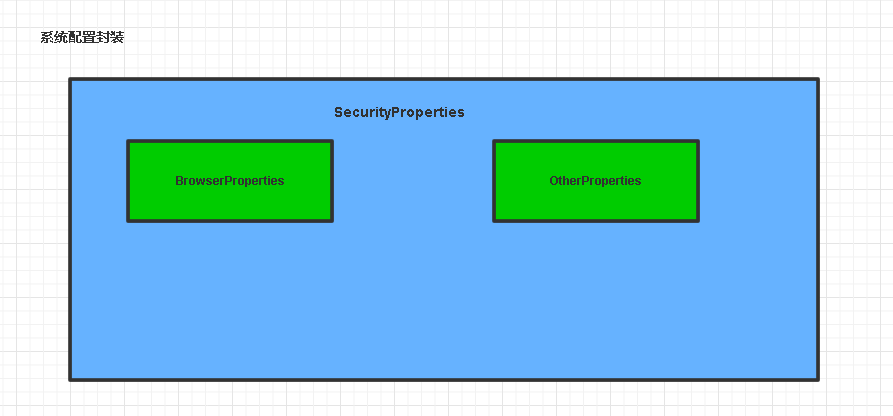
//读取配置文件内的信息
@ConfigurationProperties(prefix="core.security")
public class SecurityProperties {
private BrowserProperties browser = new BrowserProperties();
public BrowserProperties getBrowser() {
return browser;
}
public void setBrowser(BrowserProperties browser) {
this.browser = browser;
}
}
public class BrowserProperties {
//标准的登录页面,如果其他项目没有配置则使用默认的登录配置
private String loginPage = "/sign.html";
public String getLoginPage() {
return loginPage;
}
public void setLoginPage(String loginPage) {
this.loginPage = loginPage;
}
}
//为了使core.security生效则需要一个@Configuration类
@Configuration
@EnableConfigurationProperties(SecurityProperties.class)
public class SecurityCoreConfig {
}
//最后要在权限配置类**BrowserSecurityConfig**中 配置放行的url
private final static String loginPage = "/authentication/require";
@Autowired
private SecurityProperties securityProperties;
@Override
protected void configure(HttpSecurity http) throws Exception {
http.formLogin()
.loginPage(loginPage)
.loginProcessingUrl("/authentication/form")
.and()
.authorizeRequests()
.antMatchers(loginPage).permitAll()
//自定义的登录页面权限放开
.antMatchers(securityProperties.getBrowser().getLoginPage()).permitAll()
.anyRequest().authenticated()
.and()
.csrf().disable();
}第一种情况:访问请求:http://localhost:8080/user/1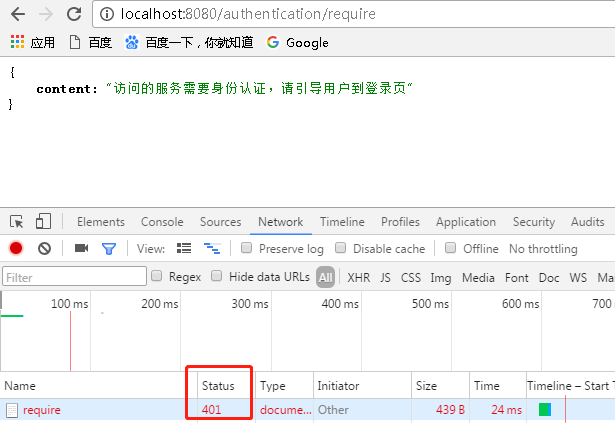
第二种情况:访问请求:http://localhost:8080/index.html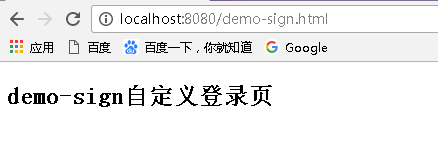
第三种情况:关闭配置,继续访问请求:http://localhost:8080/index.html
#core.security.browser.loginPage = /demo-sign.html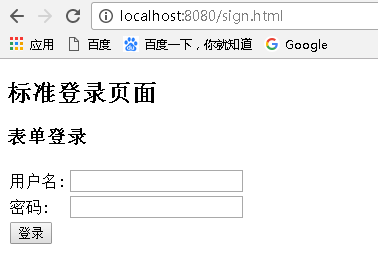
这个功能就是我们目前想要的,可以针对不同的请求对于没有权限时的拦截以及调整判断。
spring-security 个性化用户认证流程——自定义登录页面(可配置)
标签:跳转 ppi utils proc 返回 err 引导 错误信息 alt
原文地址:http://blog.51cto.com/mazongfei/2334330